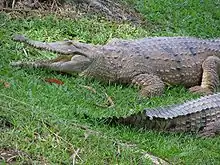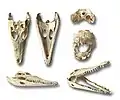Freshwater crocodile
The freshwater crocodile (Crocodylus johnstoni or Crocodylus johnsoni; see below), also known as the Australian freshwater crocodile, Johnstone's crocodile or colloquially as freshie, is a species of crocodile endemic to the northern regions of Australia.
| Freshwater crocodile Temporal range: Early Pleistocene-recent[1] | |
|---|---|
 | |
| Scientific classification | |
| Kingdom: | Animalia |
| Phylum: | Chordata |
| Class: | Reptilia |
| Order: | Crocodilia |
| Family: | Crocodylidae |
| Genus: | Crocodylus |
| Species: | C. johnstoni |
| Binomial name | |
| Crocodylus johnstoni | |
 | |
| Range of the freshwater crocodile in black | |
| Synonyms[4][5] | |
| |
Unlike their much larger Australian relative, the saltwater crocodile, freshwater crocodiles are not known as man-eaters, although they will bite in self-defence, and brief non-fatal attacks have occurred, apparently the result of mistaken identity.
Taxonomy and etymology
When Gerard Krefft named the species in 1873, he intended to commemorate the man who first reported it to him, Australian Native Police officer and amateur naturalist Robert Arthur Johnstone (1843–1905).[5][6] However, Krefft made an error in writing the name, and for many years the species has been known as C. johnsoni. Recent studies of Krefft's papers have determined the correct spelling of the name, and much of the literature has been updated to the correct usage. However, both versions still exist. According to the rules of the International Code of Zoological Nomenclature, the epithet johnstoni (rather than the original johnsoni) is correct.[7][8][9]
Description
The freshwater crocodile is a relatively small crocodilian. Males can grow to 2.3–3 m (7.5–9.8 ft) long, while females reach a maximum size of 2.1 m (6.9 ft).[7] Males commonly weigh around 70 kg (150 lb), with large specimens up to 100 kg (220 lb) or more, against the female weight of 40 kg (88 lb).[10] In areas such as Lake Argyle and Katherine Gorge there exist a handful of confirmed 4 metres (13 ft) individuals. This species is shy and has a more slender snout and have slightly smaller teeth than the dangerous saltwater crocodile. The body colour is light brown with darker bands on the body and tail—these tend to be broken up near the neck. Some individuals possess distinct bands or speckling on the snout. Body scales are relatively large, with wide, close-knit armoured plates on the back. Rounded, pebbly scales cover the flanks and outsides of the legs.[7]
Distribution and habitat
Freshwater crocodiles are found in the states of Western Australia, Queensland, and the Northern Territory. Main habitats include freshwater wetlands, billabongs, rivers and creeks. This species can live in areas where saltwater crocodiles can not, and are known to inhabit areas above the escarpment in Kakadu National Park and in very arid and rocky conditions (such as Katherine Gorge, where they are common and are relatively safe from saltwater crocodiles during the dry season). However, they are still consistently found in low-level billabongs, living alongside the saltwater crocodiles near the tidal reaches of rivers.
In May 2013, a freshwater crocodile was seen in a river near the desert town of Birdsville, hundreds of kilometres south of their normal range. A local ranger suggested that years of flooding may have washed the animal south, or it may have been dumped as a juvenile.[11]
Biology and behavior
They compete poorly with saltwater crocodiles; however, this species is saltwater tolerant. Adult crocodiles eat fish, birds, bats, reptiles and amphibians, although larger individuals may take prey as large as a wallaby.
An individual being eaten by an olive python Liasis olivaceus has been filmed; it was reported to have succumbed after a struggle of around five hours.[12]
Reproduction
Eggs are laid in holes during the Australian dry season (usually in August) and hatch at the beginning of the wet season (November/December). The crocodiles do not defend their nests during incubation. From one to five days prior to hatching, the young begin to call from within the eggs. This induces and synchronizes hatching in siblings and stimulates adults to open the nest. It is not known if the adult that opens a given nest is the female which laid the eggs. As young emerge from the nest, the adult picks them up one by one in the tip of its mouth and transports them to the water. Adults may also assist young in breaking through the egg shell by chewing or manipulating the eggs in its mouth.[13]
Diet
Feeding in the wild, freshwater crocodiles will eat a variety of invertebrate and vertebrate prey. These preys may include crustaceans, insects, spiders, fishes, frogs, turtles, snakes, birds and various mammals. Insects appear to be the most common food, followed by fish. Small prey is usually obtained by a 'sit-and-wait' method, whereby the crocodile lies motionless in shallow water and waits for fish and insects to come within close range, before they are snapped up in a sideways action. However, larger prey like wallabies and water birds may be stalked and ambushed in a manner similar to that of the saltwater crocodile.
Digestive system
The crocodiles have teeth that have adapted for capturing and holding prey, and food is swallowed without chewing. The digestive tract is short, as their food is a relatively simple thing to swallow and digest. The stomach has two compartments: a muscular gizzard that grinds food, and a digestive chamber where enzymes act on the food. The crocodile's stomach is comparatively acidic than that of any other vertebrate and contains ridges that lead to the mechanical breakdown of food. The digestion takes place at a faster pace at high temperatures.
Circulation system
The hearts of other reptiles are designed to contain three sections including two atriums and ventricle. The right atrium, which collects the returned de-oxygenated blood and the left atrium which collects the oxygenated blood collected from pulmonary arteries of the lung, takes the blood to a common ventricle. When there is just one ventricle to receive and mix oxygenated and deoxygenated blood and pump it to the body, the mixture of blood the body receives has relatively less oxygen. Crocodiles have a more complex vertebrate circulatory system, with a four-chambered heart including two ventricles. Like birds and mammals, crocodiles have heart valves that direct blood flows in a single direction through the heart chambers. When underwater, the crocodile's heart rate slows down to one or two beats a minute, and muscles receive less blood flow. When it comes out of the water and takes a breath, its heart rate speeds up in seconds, and the muscles receive oxygen-rich blood. Unlike many marine mammals, crocodiles have a small amount of myoglobin to store oxygen in their muscles.
Conservation status

Until recently, the freshwater crocodile was common in northern Australia, especially where saltwater crocodiles are absent (such as more arid inland areas and higher elevations). In recent years, the population has dropped dramatically due to the ingestion of the invasive cane toad. The toad is poisonous to freshwater crocodiles, although not to saltwater crocodiles, and the toad is rampant throughout the Australian wilderness.[14] The crocodiles are also infected by Griphobilharzia amoena, a parasitic trematode, in regions such as Darwin.[15]
Danger towards humans
Although the freshwater crocodile does not attack humans as potential prey, it can deliver a nasty bite. Brief and rapidly abandoned attacks have occurred, and were likely the result of mistaken identity (mistaking a part of the human as a typical prey item).[16][17] Other attacks have occurred in self-defense when the crocodile was touched or approached too closely.[18] There have been no known human fatalities caused by this species.[18] There have been few incidents where people have been bitten whilst swimming with freshwater crocodiles, and others incurred during scientific study. An attack by a freshwater crocodile on a human was recorded at Barramundi Gorge (also known as Maguk) in Kakadu National Park and resulted in minor injuries; the victim managed to swim and walk away from the attack. He had apparently passed directly over the crocodile in the water. However, in general, it is still considered safe to swim with this species, so long as they are not aggravated.[19] There has, however, been a freshwater crocodile attack at Lake Argyle.[20]
Gallery
 Head of a freshwater crocodile
Head of a freshwater crocodile Freshwater crocodile basking on a log
Freshwater crocodile basking on a log Various skull views of an "Australia Crocodile" (Crocodylus johnsoni)
Various skull views of an "Australia Crocodile" (Crocodylus johnsoni)
References
| Wikimedia Commons has media related to Crocodylus johnsoni. |
- "Crocodylus johnsoni Krefft 1873 (crocodile)". PBDB.
- Crocodile Specialist Group (1996). "Crocodylus johnsoni". IUCN Red List of Threatened Species. 1996. Retrieved 31 January 2010.
- "Crocodylus johnstoni". Integrated Taxonomic Information System.
- ... johnstoni means "of Johnstone", derived from the name of the first European to discover and report it to Krefft. Unfortunately Krefft misspelled the name "johnsoni " in his initial description and his subsequent correction was ignored until 1983 when the nomenclature was reviewed thoroughly by Hal Cogger (Cogger 1983). Although the majority of scientific literature, including all Australian Federal, State and Territory legislation has been using "johnstoni " correctly since then, the uncorrected version is still popular especially in the US on the basis of a later taxonomic review (King and Burke 1989) that ignored Cogger's revision. http://crocodilian.com/cnhc/csp_cjoh.htm Crocodilian Species List, Crocodylus johnstoni (KREFFT, 1873).
- "Crocodylus johnsoni ". The Reptile Database. www.reptile-database.org.
- Beolens, Bo; Watkins, Michael; Grayson, Michael (2011). The Eponym Dictionary of Reptiles. Baltimore: Johns Hopkins University Press. xiii + 296 pp. ISBN 978-1-4214-0135-5. (Crocodylus johnstoni, p. 136).
- Britton, Adam. "Crocodylus johnstoni ". Florida Museum of Natural History. Retrieved 16 June 2009.
- ICZN Code Art. 32.5
- Cogger H (1983). Reptiles and Amphibians of Australia. Reed.
- "Crocodile turns up in river near Birdsville". 23 May 2013. Retrieved 25 May 2013.
- https://www.telegraph.co.uk/travel/destinations/australiaandpacific/australia/10672439/Snake-eats-crocodile-in-battle-at-Australian-lake.html
- Somaweera, Ruchira; Shine, Richard (September 2012). "Australian freshwater crocodiles (Crocodylus johnstoni ) transport their hatchlings to the water". Journal of Herpetology. 46 (3): 407–411. doi:10.1670/11-056. S2CID 85800873.
- "Crocodiles falling victim to cane toads". ABC News. 29 December 2008.
- Platt TR, Blair D, Purdie J, Melville L (1991). "Griphobilharzia amoena n. gen., n. sp. (Digenea: Schistosomatidae), a parasite of the freshwater crocodile Crocodylus johnstoni (Reptilia: Crocodylia) from Australia, with the erection of a new subfamily, Griphobilharziinae". Journal of Parasitology. 77 (1): 65–68. doi:10.2307/3282558. JSTOR 3282558.
- CrocBITE, Worldwide Crocodilian Attack Database: Australian freshwater crocodile, 1 November 2013. Charles Darwin University, Northern Territory, Australia.
- CrocBITE, Worldwide Crocodilian Attack Database: Australian freshwater crocodile, 6 April 2006. Charles Darwin University, Northern Territory, Australia.
- Hines, K.N., and Skroblin, A. (2010). Australian Freshwater Crocodile (Crocodylus johnstoni) attacks on humans. Herpetological Review 41(4).
- http://aebrain.blogspot.com/2003/09/how-embarressing.html
- Somaweera, Ruchira (2011). "A report of a probable unprovoked attack by an Australian freshwater crocodile at Lake Argyle in Western Australia". Australian Zoologist. 35 (4): 973–976. doi:10.7882/AZ.2011.049.
Further reading
- Boulenger GA (1889). Catalogue of the Chelonians, Rhynchocephalians, and Crocodiles in the British Museum (Natural History). New Edition. London: Trustees of the British Museum (Natural History). (Taylor and Francis, printers). x + 311 pp. + Plates I–III. (Crocodilus johnstonii, pp. 279–280).
- Cogger H (2014). Reptiles and Amphibians of Australia, Seventh Edition. Clayton, Victoria, Australia: CSIRO Publishing. xxx + 1,033 pp. ISBN 978-0643100350.
- Gray JE (1874). "On Crocodilus johnstoni, Krefft". Proc. Zool. Soc. London 1874: 177–178 + Plate XXVII.
- Krefft G (1873). "Remarks on Australian Crocodiles, and Description of a New Species". Proc. Zool. Soc. London. 1873: 334–335. (Crocodilus johnsoni, new species, p. 335).
